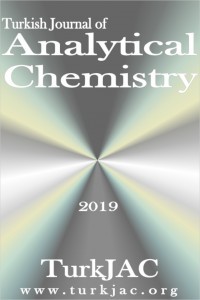The new tetra substituted metallophthalocyanines bearing four Schiff bases on periphery: Synthesis, spectroscopic properties and investigation of the effect of various central metals on aggregation properties
The new tetra substituted metallophthalocyanines bearing four Schiff bases on periphery: Synthesis, spectroscopic properties and investigation of the effect of various central metals on aggregation properties
Aggregation, Metallophthalocyanine, Phthalocyanine, Schiff base,
___
- [1] C.C. Leznoff, A.B.P. Lever. 1989. Phthalocyanines: Properties and Applications, VCH Publishers, New York, , vol. 1.
- [2] K. Kadish, K.M. Smith, R. (Eds.) Guilard, The Porphyrin Handbook, Academic Press, Boston, 2003, vol. 15–20.
- [3] N.B. McKeown, Phthalocyanine Materials Synthesis, Structure and Function, Cambridge University Press, 1998.
- [4] B. Ertem, H. Yalazan, Ö. Güngör, G. Sarkı, M. Durmuş, E.T. Saka, H. Kantekin, J. Luminescence, 204, 2018, 464‒471.
- [5] H. Kantekin, E.T. Saka, B. Ertem, M.N. Mısır, H. Yalazan, G. Sarkı, J. Coord. Chem., 71:1, 2018, 164‒182.
- [6] K. Kameyama, M. Morisue, A. Satake, Y. Kobuke, Angewandte Chemie International Edition, 44, 2005, 4763–4766.
- [7] J.L. Sesler, J. Jayawickramarajah, A. Gouloumis, G.D. Patnos, T. Torres, D.M. Guldi, Tetrahedron, 62, 2006, 2123–2131.
- [8] X. Huang, F.Q. Zhao, Z.Y. Li, L. Huang, Y.W. Tang, F. Zhang, C.H. Tung, Chemistry Letters, 36, 2007, 108–115.
- [9] X. Huang, F.Q. Zhao, Z.Y. Li, Y.W. Tang, F. Zhang, C.H. Tung, Langmuir, 23, 2007, 5167–5172.
- [10] M. Morisue, Y. Kobuke, Chemistry – A European Journal, 14, 2008, 4993–5000.
- [11] H. Manfred, Alkaloids: Nature's Curse or Blessing?,Weinheim, Wiley-VCH, 2002.
- [12] C.Y. Poon, P. Chiu, A synthesis of the tetracyclic carboskeleton of isaindigotidione. Tetrahedron Lett., 45, 2004, 2985-8.
- [13] S. Ökten, O. Çakmak, Ş. Tekin, The structure activity relationship (SAR) study of 6,8-disubstituted quinoline derivatives as anti cancer agents, Turk J Clin Lab., 8(4), 2017, 152‒159.
- [14] I. Jacquemond-Collet, F. Benoit-Vical, A. Valentin, E. Stanislas, M. Mallié, I. Fourasté Antiplasmodial and cytotoxic activity of galipinine and other tetrahydroquinolines from Galipea officinalis, Planta Med., 68(1), 2002, 68‒69.
- [15] KC. Fang, YL. Chen, J. Sheu, T.C. Wang, C.C. Tzeng, Synthesis, antibacterial, and cytotoxic evaluation of certain 7-substituted norfloxacin derivatives, J Med Chem., 43, 20, 2000, 3809‒3812.
- [16] P. Palit, P. Paira, A. Hazra, S. Banerjee, A.D. Gupta, S.G. Dastidar, N.B. Mondal, Phase transfer catalyzed synthesis of bisquinolines: Antileishmanial activity in experimental visceral leishmaniasis and in vitro antibacterial evaluation, Eur J Med Chem., 44, 2009, 845−853.
- [17] B. Podeszwa, H. Niedbala, J. Polanski, R. Musiol, D.Tabak, J.Finster, K. Serafin, M. Milczarek, J. Wietrzyk, S. Boryczka, W. Mol, J. Jampilek, J. Dohnal, D.S. Kalinowski, Dolezal, D.R. Richardson, Investigating the antiproliferative activity of quinoline-5,8-diones and styrylquinolinecarboxylic acids on tumor cell lines, Bioorganic & Medicinal Chemistry Letters, 17, 2007, 6138‒6141.
- [18] R. Musiol, J. Jampilek, V. Buchta, et al. Antifungal properties of new series of quinoline derivatives, Bioorg Med Chem., 14, 2006, 3592‒3598.
- [19] S. Ökten, O. Çakmak, R. Erenler, Ö.Y. Şahin, Ş. Tekin, Simple and convenient preparation of novel 6,8-disubstituted quinoline derivatives and their promising anticancer activities, Turk J Chem. 37, 2013, 896‒908.
- [20] S. Ökten, Ö.Y. Şahin, Ş. Tekin, O. Çakmak, In vitro antiproliferative/ cytotoxic activity of novel quinoline compound SO-18 against various cancer cell lines, J Biotechn., 185S, 2014, S37‒125.
- [21] F. Zouhiri, M. Danet, C. Benard, et al. HIV-1 replication inhibitors of the styrylquinoline class: Introduction of an additional carboxyl group at the C-5 position of the quinoline, Tetrahedron Lett., 46, 2005, 2201−2205.
- [22] A. Şahin, O. Çakmak, İ. Demirtaş, S. Ökten, A. Tutar, Efficent and selective synthesis of quinoline derivatives, Tetrahedron, 64, 2008, 10068‒10074.
- [23] S. Broch, B. Aboab, F. Anizon, P. Moreau, Synthesis and in vitro antiproliferative activities of quinoline derivatives, Eur J Med Chem., 45, 2010, 1657‒1662.
- [24] J.E. Nycz, M. Szala, G.J. Malecki, M. Nowak, J. Kusz, Spectrochimica Acta Part A: Molecular and Biomolecular Spectroscopy, 117, 2014, 351‒359.
- [25] B. Machura, J. Milek, J. Kusz, J. Nycz, D. Tabak, Polyhedron, 27, 2008, 1121‒1130.
- [26] S.D. Lytton, B. Mester, I. Dayan, H. Glickstein, J. Libman, A. Shanzer, Z.I. Cabantchik, Blood, 81, 1993, 214–221.
- [27] Z. Rezvani, L.R. Ahar, K. Nejati, S.M. Seyedahmadian, Acta Chim. Slov., 51, 2004, 675‒686.
- [28] P. Sen, S.Z. Yildiz, M. Tuna, M. Canlica, J. Organomet. Chem., 769, 2014, 38‒45.
- [29] S. Altun, A.R. Özkaya, M. Bulut, Polyhedron, 48, 2012, 31‒42.
- [30] A.W. Snow, Phthalocyanine aggregation, in: K. Kadish, R. Guilard, K.M. Smith, The Porphyrin Handbook, Phthalocyanines: Properties and Materials, vol. 17, Academic Press, Amsterdam, 2003, pp. 129‒176.
- [31] H. Enkelkamp, R.J.M. Nolte, J. Porphy. Phthalocyan., 4, 2000, 454‒459.
- [32] D.D. Dominguez, A.W. Snow, J.S. Shirk, R.S. Pong, J. Porphy. Phthalocyan., 5, 2001, 582‒592.
- Yayın Aralığı: Yılda 2 Sayı
- Başlangıç: 2019
- Yayıncı: Miraç OCAK
Halise YALAZAN, Ayşe AKTAŞ KAMİLOĞLU, Halit KANTEKİN, Ümmühan OCAK
Voltammetric analysis of class II antiarrhythmic drugs propranolol and acebutolol
Adsorptive removal of Cr(VI) ions from aqueous solutions by H2SO4 modified oak (Quercus L.) sawdust
Duygu ÖZDEŞ, İbrahim YILDIRIM, Celal DURAN
Preparation and characterization of flexible and free-standing CuS/rGO composite paper
Ezgi TOPÇU, Kader DAĞCI KIRANŞAN
Saliha DİNÇ, Rabia GÜNHAN ÖZMELLEŞ
Ceren KUŞCU, Volkan ÖZDOKUR, Süleyman KOÇAK, Fatma Nil ERTAS
